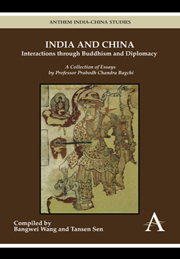 India and China: Interactions through Buddhism and Diplomacy
India and China: Interactions through Buddhism and Diplomacy Book contents
Sino-Indian Spheres of Influences
from Part Two - Short Articles
Published online by Cambridge University Press: 05 March 2012
Summary
In ancient times, as now, there were certain spheres of influences. But these spheres were not determined so much by political or economic conditions as by cultural factors. The exploitation, in the modern sense, of smaller countries by bigger ones was wholly unknown and modern methods of colonisation had not evolved. Slow and gradual expansion of culture had brought into existence certain zones but has also an unconscious process and not a deliberate im position which is generally fraught with subversive reactions.
In Eastern Asia two such zones had come into existence of which one was the Chinese and the other the Indian. The cultural expan sion had produced what may be called a Greater China (Maha-Cina) and a Greater India (Maha-Bharat). These zones, however, were not exclusive and in certain areas they penetrated each other and produced cultural buffers. Some of the modern geographical terms, such as Indo-China, Indonesia, Ser-India (for Eastern Turkestan) still faithfully perpetuate the traditions of old cultural contacts.
There were two cradles of civilisation in Eastern Asia – China and India. The old Chinese civilisation was evolved in the province of Kan-su about 4000 years ago and thence it was carried to the fertile valleys of the Hwang-ho and its effluents. It gradually spread to other parts of the country and the aboriginal tribes slowly came under its influence.
- Type
- Chapter
- Information
- India and China: Interactions through Buddhism and DiplomacyA Collection of Essays by Professor Prabodh Chandra Bagchi, pp. 179 - 184Publisher: Anthem PressPrint publication year: 2011


